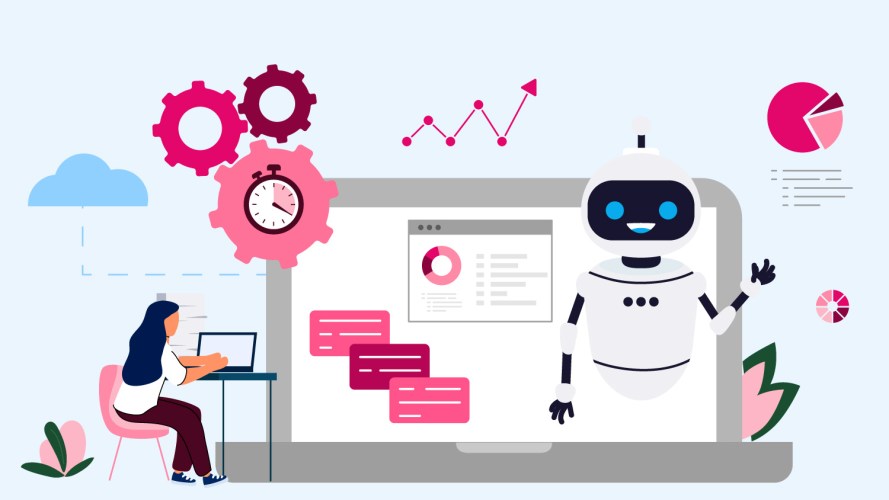5 Customer Service Trends You Need to Watch

Our latest research reveals the top customer service trends as leaders shift their focus from cost-cutting to revenue generation.

Rekha Srivatsan
As technology advances, the state of customer service changes along with it. Customers expect companies to adapt to their needs, and technologies like generative AI are playing a major role in meeting those evolving expectations. Here are five customer service trends to keep on your radar as you prepare for the future of customer service, based on new data from the “State of Service” report.
Table of contents
- 1. Service organizations are now revenue generators — not cost centers
- 2. Self-service is a clear competitive advantage
- 3. Connected data enables a better customer experience
- 4. Conversational AI is taking proactive, personalized service to the next level
- 5. AI is improving productivity and safety in the field
- Staying one step ahead of customer service trends
Dig into our latest customer service research
High-performing service organizations are using data and AI to generate revenue while cutting costs — without sacrificing the customer experience. Find out how in the 6th edition of the State of Service report.



1. Service organizations are now revenue generators — not cost centers
Companies are looking for new ways to drive growth and protect their margins, and many see service as a prime opportunity. In fact, 85% of decision makers say service is expected to contribute a larger share of revenue this year.
So how can you take action? Our research shows that leading organizations are actively tracking key performance indicators (KPIs) that are linked to tangible business outcomes. In fact, the share of service organizations tracking revenue generation has nearly doubled since 2018, from 51% to an astonishing 91%. The share tracking customer retention rose by 29 percentage points over the same period. If those customer service analytics aren’t already on your radar, it’s time to make some changes — otherwise you risk getting left behind. (back to top)
2. Self-service is a clear competitive advantage
Self-service helps customers resolve simple issues, freeing agents to spend more time on high-complexity, high-value interactions.
Our latest research shows that high-performing organizations are much more likely than underperformers to provide self-service tools like knowledge-powered help centers, customer self-service portals, and chatbots powered by AI. When customers can interact with a chatbot to answer a question or use a guided journey to start a return, live agents have the time they need to manage more complicated requests. That’s critically important for the 69% of agents who report difficulty balancing speed and quality. (back to top)
3. Connected data enables a better customer experience
Many organizations keep data in different silos or applications, so it’s difficult to get a complete view of the customer across all channels.
Bringing customer data together is all about creating an end-to-end view of the entire customer journey. This way, you’ll have a continuous feedback loop between sales, service, and marketing, keeping everyone on the same page. Maybe that’s why 82% of high-performing organizations use the same customer relationship management (CRM) platform across all departments — up from 62% just two years ago.
The stakes are high: 92% of analytics and IT leaders say the need for trustworthy data is greater than ever. That’s why privacy, security, and trust have already become a major competitive advantage in the evolving AI landscape.
As companies try to stay one step ahead of these and other customer service trends, leading organizations are adopting programs that prevent large-language models (LLMs) from retaining sensitive customer data. More organizations are training their own domain-specific models to access a secure AI cloud while storing data on their own infrastructure. These efforts are essential to preserving customers’ loyalty and trust in the years to come. (back to top)
Join the Serviceblazer community
We’d love for you to join our amazing community of Serviceblazers. Connect with fellow service pros, tap into industry trends, and grow your career.

4. Conversational AI is taking proactive, personalized service to the next level
When it comes to meeting customers’ sky-high expectations, proactive service is more important than ever. “It’s essential to proactively resolve issues before they have any significant business impact,” says Jules O’Donnell, Salesforce administration manager at Quickbase. “This means keeping up with technology solutions to scale service and meet customers where they are.”
Our latest research backs that up: 95% of decision makers at organizations with AI report cost and time savings, and 92% say generative AI helps them deliver better customer service. It should come as no surprise, then, that 83% of decision makers plan to increase their AI investment over the next year, while only 6% say they have no plans for the technology whatsoever.
The introduction of conversational AI assistants is one of the innovations that’s making these benefits possible. From the contact center to the field, AI assistants surface the right information at the right time to enable proactive service, improve Net Promoter Scores, and increase loyalty.
Here’s what that looks like in practice:
- Responding to customers with personalized, relevant answers grounded in trusted company knowledge across any preferred channel — including email, SMS, live chat, and social media
- Resolving customer issues faster using generative answers seamlessly integrated into agents’ and technicians’ flow of work
- Autonomously completing tasks like auto-summarizing intricate support cases and field work orders (back to top)
5. AI is improving productivity and safety in the field
Our research shows that mobile workers say innovative field service technologies make them feel safer and more effective at their jobs, empowering them to be better brand ambassadors. These technologies include intelligent scheduling, route optimization, AI-generated reports, and augmented reality (which can create detailed 3D rendering of large areas in seconds).
One of the emerging benefits of these and other technologies is the ability to generate insights and predict job duration. For example, workers can use AI to easily view asset condition as well as maintenance and repair history, then schedule proactive service to minimize downtime.
Customers are benefiting, too. They can book and reschedule their own appointments using intelligent appointment assistance. And many customers have the ability to check when a technician is on the way, reducing no-shows and call volume for a better customer experience all around. (back to top)
Staying one step ahead of customer service trends
A great strategy starts with the right questions. How can you pursue innovation while maintaining the integrity of your data? How do you build customers’ loyalty and trust? And what’s the secret to delivering faster, more effective customer service without breaking the bank?
The right technologies can help you prepare for the future while keeping up with the latest customer service trends. That’s why your organization must combine people, technology, and processes to deliver faster, more effective service at scale — with AI assisting you every step of the way. (back to top)
Enable stellar service in the age of AI
You can scale your customer service with the power of generative AI on a unified foundation of trusted data. See how this technology improves efficiency and generates revenue from the contact center to the field.


























